
by Rick O'Connor | Oct 6, 2021
EDRR Invasive Species
Swamp Morning Glory – Water Spinach (Ipomoea aquatica)

Swamp Morning Glory (also known as Water Spinach)
Photo: University of Florida IFAS Center for Aquatic and Invasive Plants
Define Invasive Species: must have ALL of the following –
- Is non-native to the area, in our case northwest Florida
- Introduced by humans, whether intentional or accidental
- Causing either an environmental or economic problem, possibly both
Define EDRR Species: Early Detection Rapid Response. These are species that are either –
- Not currently in the area, in our case the Six Rivers CISMA, but a potential threat
- In the area but in small numbers and could be eradicated
Native Range:
Swamp Morning Glory, also known as Water Spinach, is native to the East Indies.
Introduction:
The plant was cultivated in many southeast Asian countries during World War II and was known as “water spinach”. It was later brought to the U.S. and cultivated in California, Florida, Hawaii, Texas, and Arizona. It escaped cultivation.
EDDMapS currently list 48 records of Swamp Morning Glory in the U.S. Three are in northern California, one in Texas, and the remaining 44 are from Florida. Two of those in Florida are from the panhandle in Walton County near Miramar Beach and are within the Six Rivers CISMA.
Description:
The plant appears as a trailing herbaceous vine in aquatic systems and produces a milky sap. The leaves are alternate and simple. The blades are arrowhead shaped but can vary. They usually end in a point and are about 7 inches long. They are held above the water most of the time.
The flowers are pretty and showy being funnel shaped. They are white to pink in color.
Issues and Impacts:
This plant forms dense mats at the surface blocking needed sunlight to submerged species. The vines can grow over 70 feet in length and can present problems with flood control. It also competes with native emergent plants for space and resources.
Management:
Aquatic herbicides have been used but only with temporary relief. Diuron provided satisfactory control on plants growing in dry ditches but was nonselective and killed other nearby plants. Paraquat, glyphosate, and 2,4-D have been shown to have control over growth of the plant but are also nonselective and will kill other plants it comes in contact with.
For more information on this EDRR species, contact your local extension office.
References
Global Invasive Species Database. Ipomoea aquatica. http://issg.org/database/species/management_info.asp?si=477&fr=1&sts=&lang=EN.
Ipomoea aquatica. 2021. Wikipedia. https://en.wikipedia.org/wiki/Ipomoea_aquatica.
Water Spinach (Ipomoea aquatica). 2021. Center for Invasive Species and Ecosystem Health. https://plants.ifas.ufl.edu/plant-directory/ipomoea-aquatica/.
Water Spinach. Florida Fish and Wildlife Conservation Commission. https://myfwc.com/wildlifehabitats/habitat/invasive-plants/weed-alerts/water-spinach/.
Early Detection and Distribution Mapping System (EDDMapS)
https://www.eddmaps.org/
Six Rivers CISMA
https://www.floridainvasives.org/sixrivers/

by Rick O'Connor | Sep 23, 2021
In Part 3 we are going to look at the most recent Assessment Report No.6 (AR6) published by the Intergovernmental Panel on Climate Change. This document is 3,946 pages – so, we will focus only on the executive summary for policy makers. This summary circles on the key points of the report. It was published August 7, 2021.
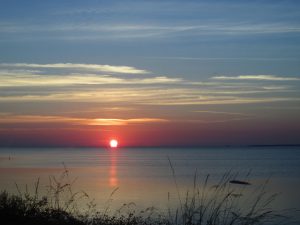
Sunrise over Apalachicola Bay in Northwest Florida
The Intergovernmental Panel on Climate Change
Who is the IPCC?
It is a panel developed by the United Nations to address the topic of global climate change. It was created in 1988 by the World Meteorological Organization and the United Nations Environmental Programme. It currently has 195 members and contributions from thousands of scientists. The panel scientists volunteer their time to review all of the scientific papers that are used in the assessment reports. The panel meets one or more times a year1.
IPCC Assessment Report Six (AR6) – August 7, 2021
All of the assessment reports are based on scientific information and presented as statements of fact, or statements at a level of confidence using an IPCC calibrated language (such as likely, medium confidence, high confidence, etc.). The summary for policy makers is divided into four sections. We will summarize each one.
- Current State of the Climate
- Possible Climate Futures
- Climate Information for Risk Assessment and Regional Adaptation
- Limiting Future Climate Change
- Current State of the Climate
A.1) It is unequivocal that human influence has warmed the atmosphere, ocean, and land. Widespread and rapid changes in the atmosphere, ocean, cryosphere, and biosphere have occurred.
The definition of unequivocal is “leaving no doubt, unquestionable, clear”. Using that term here indicates the panel is convinced that the current warming of our planet is caused by human activity. Thus, there is something we can do to turn it around.
Other statements in this section include:
- Each of the last four decades has been successively warmer than any decade preceded it since 1850.
- Globally averaged precipitation over land has likely increased since 1950, with a faster rate of increase since the 1980s.
This term likely is one of the terms used by their calibrated language model. Suggesting the confidence level is not as high – but likely.
- It is likely that human influence contributed to the pattern of observed precipitation change since the mid-20th century, and extremely likely that human influence contributed to the pattern of observed changes in near-surface ocean salinity.
- Mid-latitude storm tracks have likely shifted poleward in both hemispheres since the 1980s.
- Human influence is very likely the main driver of the global retreat of glaciers since the 1990s and the decrease in the Arctic Sea ice area between 1979-1988 and 2010-2019 is about 40% in September and 10% in March.
- It is virtually certain that the global upper ocean (0-2400 feet) has warmed since the 1970s and extremely likely that human influence is the main driver.
- Global mean sea level increased by 0.7 feet between 1901 and 2018.
- Changes in land ecosystems since 1970 are consistent with global warming. Climate zones have shifted poleward in both hemispheres and growing seasons have, on average, lengthened by up to two days per decade since the 1950s. This is stated with high confidence.
A.2) The scale of recent changes across the climate system as a whole and the present state of many aspects of the climate system are unprecedented over many centuries to many thousand years.
- In 2019, atmospheric CO2 concentrations were higher than at any time in at least 2 million years (high confidence), and concentrations of CH4 (methane) and N2O (nitrous oxide) were higher than at any time in at least 800,000 years (very high confidence).
- Global surface temperature has increased faster since 1970 than in any other 50-year period over at least the last 2000 years (high confidence).
- In 2011-2020, annual average Arctic Sea ice area reached its lowest level since at least 1850 (high confidence).
- Global mean sea level has risen faster since 1900 than over any preceding century in at least the last 3000 years (high confidence).
A.3) Human-Induced climate change is already affecting many weather and climate extremes in every region across the globe. Evidence in observed changes in extremes such as heatwaves, heavy precipitation, droughts, tropical cyclone, and (in particular) their attribution to human influence, has strengthen since AR5.
- It is virtually certain that hot extremes have become more frequent and more intense across most land regions since the 1950s, while cold extremes have become less frequent and less severe, and that human-induced climate change is the main driver (high confidence).
- The frequency and intensity of heavy precipitation events have increased since the 1950s over most land area for which observational data are sufficient for trend analysis (high confidence), and human-induced climate change is the main driver (likely).
- It is likely that the global proportion of major (Category 3-5) tropical cyclone occurrence has increased over the last four decades, and the latitude where the cyclones reach their peak intensity has shifted northward. These changes cannot be explained by internal variability alone (medium confidence). There is low confidence in long-term (multi-decade to centennial) trends in the frequency of all-category tropical cyclones. Event attribution studies and physical understanding indicate that human-induced climate change increases heavy precipitation associated with tropical cyclones (high confidence), but data limitations inhibit clear detection of past trends on the global scale.
- Human influence has likely increased the chance of compound extreme events since the 1950s.
- Possible Climate Futures
B1. Global surface temperature will continue to increase until at least the mid-century under all emissions scenarios considered. Global warming of 1.5°C and 2°C will be exceeded during the 21st century unless deep reduction in CO2 and other greenhouse gas emissions occur in the coming decades.
- Compared to 1850-1900, global surface temperature averaged over 2081-2100 is very likely to be higher than 1.0°C to 1.8°C under the VERY LOW greenhouse gas emissions scenario. 1°C – 3.5°C in the INTERMEDIATE scenario. And 3.3°C to 5.7°C under the VERY HIGH scenario.
- Global surface temperature in any single year can vary above or below the long-term human-induced trend, due to substantial natural variability.
B2. Many changes in the climate system become larger in direct relation to increasing global warming. They include increases in the frequency and intensity of hot extremes, marine heatwaves, heavy precipitation, agricultural and ecological droughts in some regions, and proportion of intense tropical cyclones, as well as reductions in Arctic Sea ice, snow cover, and permafrost.
- It is virtually certain that the land surface will continue to warm more than the ocean surface. It is virtually certain that the Arctic will continue to warm more than the global surface temperature.
- With every additional increment of global warming, changes in extremes continue to become larger.
- Some mid-latitude and semi-arid regions, and the South American Monsoon region, are projected to see the highest increase in the temperature of the hottest days, about 1.5 to 2 times the global rate of warming (high confidence).
- It is very likely that heavy precipitation events will intensify and become more frequent in most regions with additional global warming.
- Additional warming is projected to further amplify permafrost thawing, and loss of seasonal snow cover, of land ice, and of Arctic Sea ice (high confidence).
B3. Continued global warming is projected to further intensify the global water cycle, including its variability, global monsoon precipitation and severity of wet and dry events.
- There is strengthened evidence since AR5 that the global water cycle will continue to intensify as global temperatures rise (high confidence), with precipitation and surface water flows projected to become more variable over most land regions within seasons (high confidence) and from year to year (medium confidence).
- A warmer climate will intensify very wet and very dry weather and climate events and seasons, with implications for flooding and droughts (high confidence), but the location and frequency will depend on projected changes in regional and atmospheric circulation, including monsoons and mid-latitude storm tracks.
B4. Under scenarios with increasing CO2 emissions, the ocean and land carbon sinks are projected to be less effective at slowing the accumulation of CO2 in the atmosphere.
- Based on model projections, under the intermediate scenario that stabilizes atmospheric CO2 concentrations this century, the rates of CO2 taken up by the land and oceans are projected to decrease in the second half of the 21st century (high confidence).
B5. Many changes due to past and future greenhouse gas emissions are irreversible for centuries to millennia, especially changes in the ocean, ice sheets, and global sea level.
- Past greenhouse gas emissions since 1750 have committed the global ocean to future warming (high confidence).
- Mountain and polar glaciers are committed to continue melting for decades or centuries (very high confidence).
- It is virtually certain that global mean sea level will continue to rise over the 21st
- In the longer term, sea level is committed to rise for centuries to millennia due to deep ocean warming and ice sheet melt and will remain elevated for thousands of years (high confidence).
- Climate Information for Risk Assessment and Regional Adaptation
C1. Natural drivers and internal variability will modulate human-induced changes, especially at regional scales and in the near term, with little effect on centennial global warming. The modulations are important to consider in planning for the full range of possible changes.
What this is basically stating is that the predictions made with the computer models, can be altered by natural drivers (such as nearby ocean currents, forested land, or even urban-induced weather) as well as internal variability (such as the humidity at time of cyclone formation, wind conditions during a heavy rainfall, etc.). These are regional impacts and are not accounted for in the models.
C2. With further global warming, every region is projected to increasingly experience concurrent and multiple changes in climate impact-drivers. Changes in several climatic impact-drivers would be more widespread to 2°C compared to 1.5°C global warming and even more widespread and/or pronounced for higher warming levels.
Basically… as the model predictions occur, their impacts on the climate can change enough that the data inputted into the model could be warmer than anticipated and thus, increase the outcome predicted.
- It is very likely to virtually certain that regional mean relative sea level rise will continue throughout the 21st century, except in a few regions with substantial geologic land uplift rates.
- Cities intensify human-induced warming locally, and further urbanization together with more
frequent hot extremes will increase the severity of heatwaves (very high confidence).
- Many regions are projected to experience an increase in the probability of compound events with higher global warming (high confidence).
C3. Low-likelihood outcomes, such as ice sheet collapse, abrupt ocean circulations changes, some compound extreme events and warming substantially larger than the assessed very likely ranges of future warming cannot be ruled out and are part of risk assessment.
Unpredictable and rare natural events not related to human influence on climate may lead to low likelihood, high impact outcomes.
- Limiting Future Climate Change
D1. From a physical science perspective, limiting human-induced global warming to a specific level requires limiting CO2 emissions, reaching at least net zero CO2 emissions, along with strong reductions in other greenhouse gases. Strong, rapid and sustained reductions in CH4 (methane) emissions would also limit the warming effect resulting from the declining aerosol pollution and would improve air quality.
- Removing CO2 by humans leading to net negative emissions would reverse surface ocean acidification (high confidence).
- If global net negative CO2 emissions were to be achieved and be sustained, the global CO2-induced surface temperature increase would gradually reverse, but other climate change would continue in their current direction for decades to millennia (high confidence). For instance, it would take several centuries to millennia for global mean sea level to reverse course even under large net negative CO2 emissions (high confidence).
D2. Scenarios with very low or low greenhouse gas emissions lead within years to discernible effects on greenhouse gas and aerosol concentrations, and air quality, relative to high and very greenhouse gas emissions scenarios. Under these contrasting scenarios, discernible differences in trends of global surface temperature would begin to emerge from natural variability within around 20 years, and over longer time periods for many other climate impact-drivers (high confidence).
Basically… at high confidence – if we can reduce the amount of greenhouse gas emissions to match the low emission scenario used by the models, the climate outcomes would be reduced as well.
- Emissions reductions in 2020 associated with measures to reduce the spread of COVID-19 led to temporary but detectible effects on air pollution (high confidence), and an associated small, temporary increase in total radiative forcing, primarily due to reductions in cooling caused by aerosols arising from human activities (medium confidence).
- Scenarios with very low or low GHG emissions would have rapid and sustained effects to limit human-caused climate change, compared with scenarios with high or very high GHG emissions, but early responses of the climate system can be masked by natural variability.
SUMMARY OF THIS REPORT
- Based on the report – there is no doubt that human-induced greenhouse gases have warmed the planet.
- The climatic changes observed over the last century are unprecedented.
- Weather and climate extremes are occurring.
- No matter what we do, global surface temperatures will continue to increase until mid-century.
- If the annual increases in greenhouse gas emissions continues, their weather/climate impacts will increase as well.
- If emissions continue at their present rate, the carbon sinks (methods of removing carbon – both land and ocean) will become less effective.
- With high confidence – some impacts are irreversible – oceans will continue to warm, ice sheets and glaciers will continue to melt, and sea level will continue to rise for centuries and millennia.
- There are local and regional features (nearby ocean currents, forested – or deforested areas, nearby mountain ranges) that can alter the impacts of the computer models for better or worse, than the scenarios presented.
- Some regional climate impacts can affect the outcomes as such as multiple events can occur.
- By reducing greenhouse gases, we can alter some of the impacts predicted in these scenarios.
COMMENTS
Much of this sounds bad… and it is. As we mentioned in Part 1 “everyone is talking about the climate… but no one is doing anything about it” is not 100% true… many are doing something about it. But based on this AR6 report, not enough. The AR6 report also mentions that many of the climate/weather scenarios can be altered if we do begin to make some behavioral changes on the amount of greenhouse gasses we emit AND look into sources of carbon sequestering.
In Part 4 of this series, we will look closer at the impacts this is having on the Florida panhandle.

The Gulf of Mexico as seen from Pensacola Beach.
Photo: Molly O’Connor
References
1 The Intergovernmental Panel on Climate Change
https://www.ipcc.ch/
2 IPCC, 2021: Summary for Policymakers. In: Climate Change 2021: The Physical Science Basis.
Contribution of Working Group I to the Sixth Assessment Report of the Intergovernmental Panel on Climate Change [Masson-Delmotte, V., P. Zhai, A. Pirani, S. L. Connors, C. Péan, S. Berger, N. Caud, Y. Chen, L. Goldfarb, M. I. Gomis, M. Huang, K. Leitzell, E. Lonnoy, J.B.R. Matthews, T. K. Maycock, T. Waterfield, O. Yelekçi, R. Yu and B. Zhou (eds.)]. Cambridge University Press. In Press.

by Rick O'Connor | Sep 23, 2021
These are all fish that many have heard of but know nothing about. They are not even sure what they look like. We have heard of them as a seafood product. Smoked herring, canned sardines, and anchovy pizza are popular the world over. These are one of the largest commercial species harvested in U.S. waters. In 2020 over 6 million pounds of sardines, 12 million pounds of anchovies, 41 million pounds of herring, 1.3 BILLION pounds of menhaden were harvested. The menhaden catch alone was valued at just under $200 million2. It not as large a fishery in Florida. 327,000 pounds of menhaden, 700,000 pounds of sardines, and 1.8 million pounds of herring were harvested from state waters in 2020 and at value of about $900,000 in 2020. The fish are popular in many European dishes, cat food, and menhaden oil is used in many products.
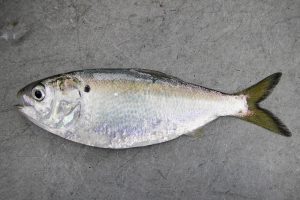
The Gulf menhaden supports a large commercial fishery in the Gulf of Mexico.
Photo: NOAA
These fishes are actually divided into two families. The herring, sardine, and menhaden are in the Family Clupeidae and are often called “clupeids”. This family includes 11 species in the northern Gulf of Mexico. Most have a “hatchet” shape to their bodies – being straight along their back with a deep curve along the ventral side, and most having a forked, or lunate, tail. They average between 2-20 inches in length and form massive schools as they travel near the surface waters filtering plankton. They are often harvested using purse seines. Large factory vessels will plow the waters searching for the large schools. Often, they will use aerial assistance to search such as small airplanes or ultralights. Once spotted, small chase boats will be launched from the factory vessel hauling the large purse seine around the school. Once that is completed a large weight called a “tommy” is dropped that “zips” the purse shut and captures the fish. There is little bycatch in this method.
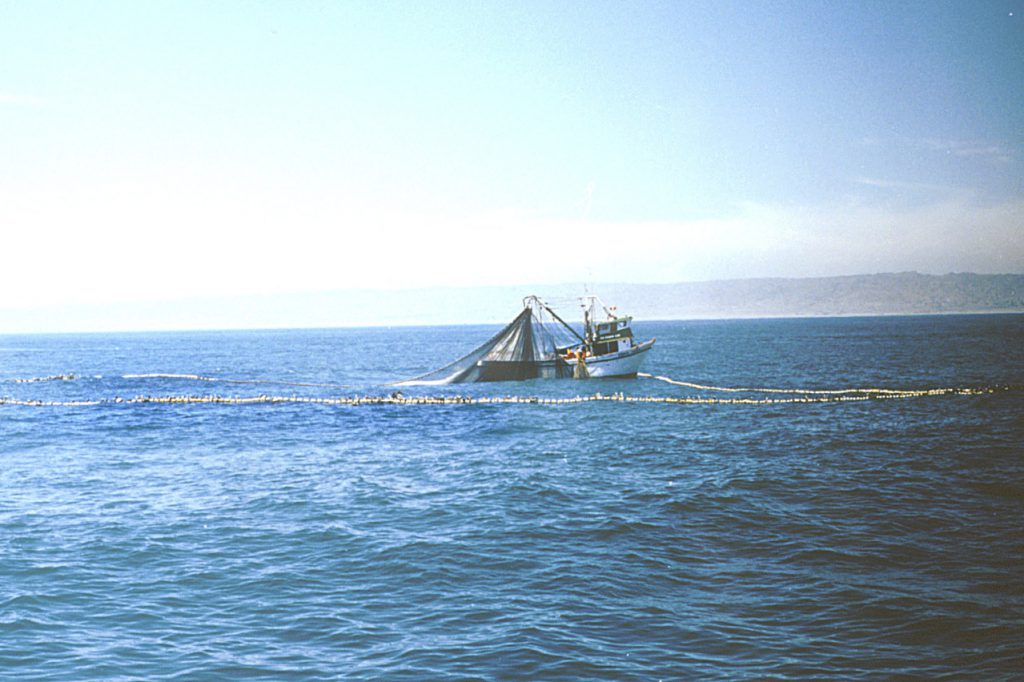
Purse seining in the Pacific Ocean.
Photo: NOAA
The anchovies are found in the family Engraulidae. They differ in that they are more streamlined in shape and their mouths are larger / body size than the clupeids. Though there is no commercial fishery for them in Florida, they comprise one of the largest groups of schooling fish in the northern Gulf of Mexico. Hoese and Moore mention that the local species are too small for a fishery. The five native species average between 2.5-5.5 inches in length1. Some marine biologists consider anchovies as an “environmental canary”, or indicator species. Their presence can suggest good water quality. I have often caught them in seines along the beach in the Pensacola area. They resemble the very common silverside minnow in that they have a silver stripe running down their sides. But they differ in that they (a) only have a single dorsal fin (silversides have two), and (b) their snouts extend to a point resembling the head of a shark.
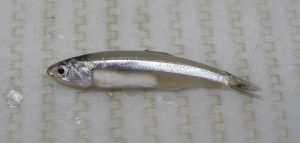
This striped anchovy resembles a silver side but differs with the shape of its snout and the number of dorsal fins.
Photo: NOAA
The distribution and biogeography of this group of fishes is all over the place. The round herring (Etrumeus teres) has few barriers and is found from the Bay of Fundy (at the Canadian/Maine border) to the Pacific Ocean1! A few species have the classic “Carolina” distribution – meaning they are found from North Carolina south, the entire Gulf of Mexico, and down to Brazil. For whatever reason (currents, water temperature, other) they do not venture north of the Carolinas and are probably impacted by the large amount of freshwater entering the Atlantic Ocean near the Amazon River.
Twp species are restricted by tropical conditions. The tiny dwarf herring (Jenkinsia lamprotaenia) and the Spanish sardine (Sardinella anchovia) are both listed as being restricted by water temperatures, though I have captured plenty of the Spanish sardines in the Pensacola area.
Some species are restricted to either the eastern or western Gulf of Mexico. Usually, the barrier for this distribution is the Mississippi River. Like the Amazon, there is a large plume of highly turbid/low salinity water extending into the Gulf of Mexico which keeps some species from crossing. Hoese and Moore report the Alabama shad (Alosa alabamae) only from the area between the Mississippi River and the Florida panhandle. The Mississippi River to one side, and the Apalachicola on the other.

Clupeids, like this Pacific sardine, for m large schools can consist of literally millions of fish.
Photo: NOAA
And finally, there is a spatial distribution with some species between freshwater, estuaries, and the open shelf. Two species, the threadfin shad (Dorosoma petenense) and the gizzard shad (Dorosoma cepedianum) are more associated with freshwater. The scaled sardine (Harengula pensacolae) is more common on the open shelf of the Gulf.
We all know the names of these fish but are unaware of their general biology and importance to commercial fisheries around the world. Many are common in our estuaries and play an important role in the health of the overall ecology. They are important members of the “panhandle fish family”.
References
1 Hoese, H.D., R.H. Moore. 1977. Fishes of the Gulf of Mexico; Texas, Louisiana, and Adjacent Waters. Texas A&M Press, College Station TX. Pp. 327.
2 NOAA Fisheries. 2021. Commercial Landings. https://www.fisheries.noaa.gov/foss/f?p=215:200:2082956461436::NO:::.
3 Florida Commercial Landings. 2021. Florida Fish and Wildlife Conservation Commission. https://myfwc.com/research/saltwater/fishstats/commercial-fisheries/landings-in-florida/.
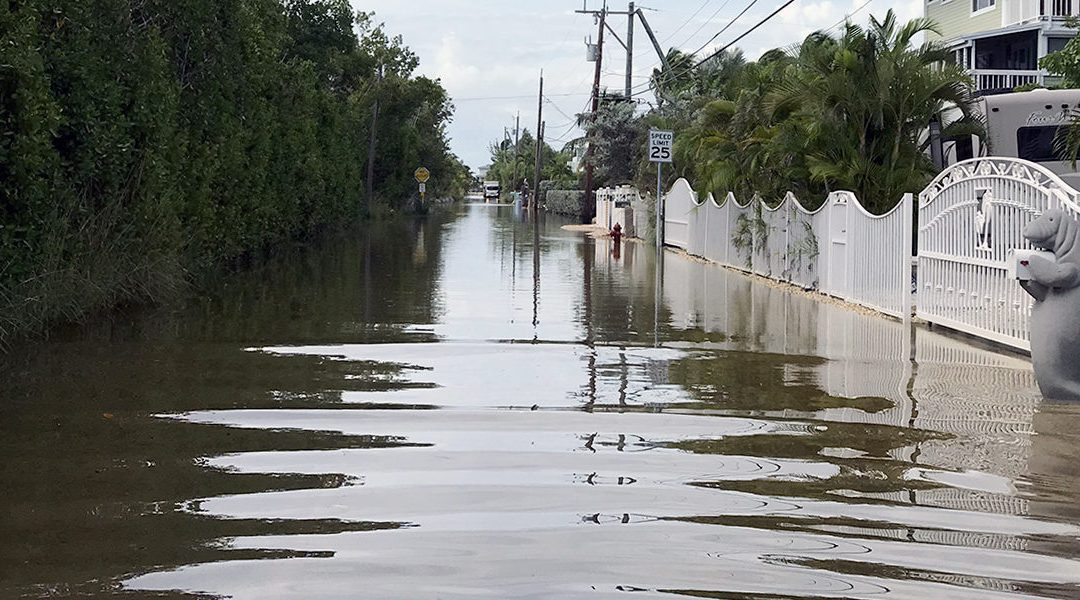
by Rick O'Connor | Sep 17, 2021
In Part 1 we looked at the history, and the science, behind the climate change issue. That post discussed everything said during the early periods up to about 2010. In this post, we will look at what has happened since 2010 and will look at how the early prediction models are working. We will begin with how CO2 levels have changed over the last decade.
CO2 concentrations since 2007
It was mentioned in Part 1 that at the beginning of the industrial revolution the CO2 concentration in the atmosphere was at 280 ppm and had reached 384 ppm by 2007. It was also mentioned that many considered the “tipping point” for CO2 concentration was at 450 ppm11. What has happened since 2007? NOAA reports that the CO2 levels have reached 409.8 ppm (±1.0 ppm) in 2019. This is the highest recorded CO2 value in the last 800,000 years4. This suggests that greenhouse admissions do continue to climb at a rate of about 2 ppm/year. At this rate, we will pass the potential “tipping point” of 450 ppm by 2050. For obvious reasons, this is concerning.
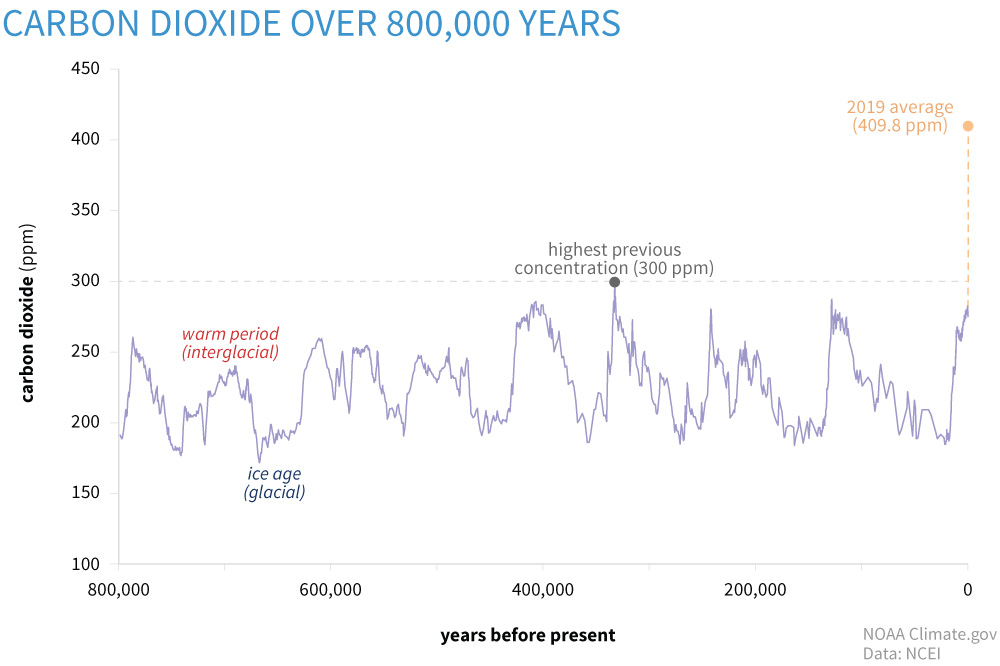
Changes in carbon dioxide levels up to 2019.
Image: NOAA
What about extreme weather conditions?
Everyone has noticed the extreme weather conditions posted on the evening news each day. Fires out west, droughts in the southwest, floods in the Mississippi Valley, hurricanes along the Gulf coast, and blizzards/floods/and even tornados in the northeast. There have been catastrophic floods in Europe, and extreme droughts in equatorial Africa. These things have always happened, but they now seem to be more frequent, and more concerning to residents in these areas where they continually occur. They certainly match the pattern predicted by the climate models of the early 1980s and it is hard to argue when in 2020 the named tropical storms went through the entire alphabet and into the Greek alphabet before the storm season was over. Are these becoming more common? Or do they appear to be more common?
A 2021 NOAA publication on sea level rise suggest it is likely that tropical storm frequencies will increase. They work from what is called the power dissipation index (PDI). This index measures storm activity, frequency, duration, and intensity. Correlating the annual index against the annual sea surface temperatures (SSTs) of the Atlantic suggest, at medium to high confidence, the intensity of future tropical storms will increase. But they point out the frequency of storms prior to 1965 was based on ship observations at sea. Numerous storms form over the Atlantic Ocean but only last for a few days and may not make landfall. They argue that some of these could have been missed using the ship observation methods of the early 20th century. One study made a correction for this in their calculations which suggested that the frequency of todays storms may not be that significantly different from those of the earlier 20th century and that the increase could be due to better monitoring today6,7. Either way, it has become custom along the northern Gulf of Mexico to prepare for hurricanes each season, and possibly more than one. As I am writing this, it is early September, and we are currently on storm “N” – Nicholas – the 14th named storm of the season. This is certainly something that warrants continued monitoring.
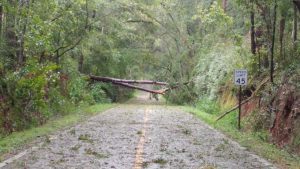
Hurricanes seem to becoming more frequent bringing more frequent damage.
Photo: Dr. Pete Vergot
Record temperatures
At one point during the summer of 2021 there were triple digit air temperatures all over the country. For Arizona, Texas, and Florida it is not unusual to see these high temperatures. But Oregon, North Dakota, and New England it was unusual. It seems we are breaking records on high temperatures each year, and sometimes multiple times a year for some locations. Does the science support what appears to be happening?
Yes…
The data shows the most intense period of warming has occurred in the last 40 years and the seven most recent years are the warmest on record. This publication from NASA also states that 2016 and 2020 tied for the highest record warm days since they began collecting this data, and not only are the records highs increasing – the low temperatures reported from around the country having been increasing since 1950. It is getting warmer3.
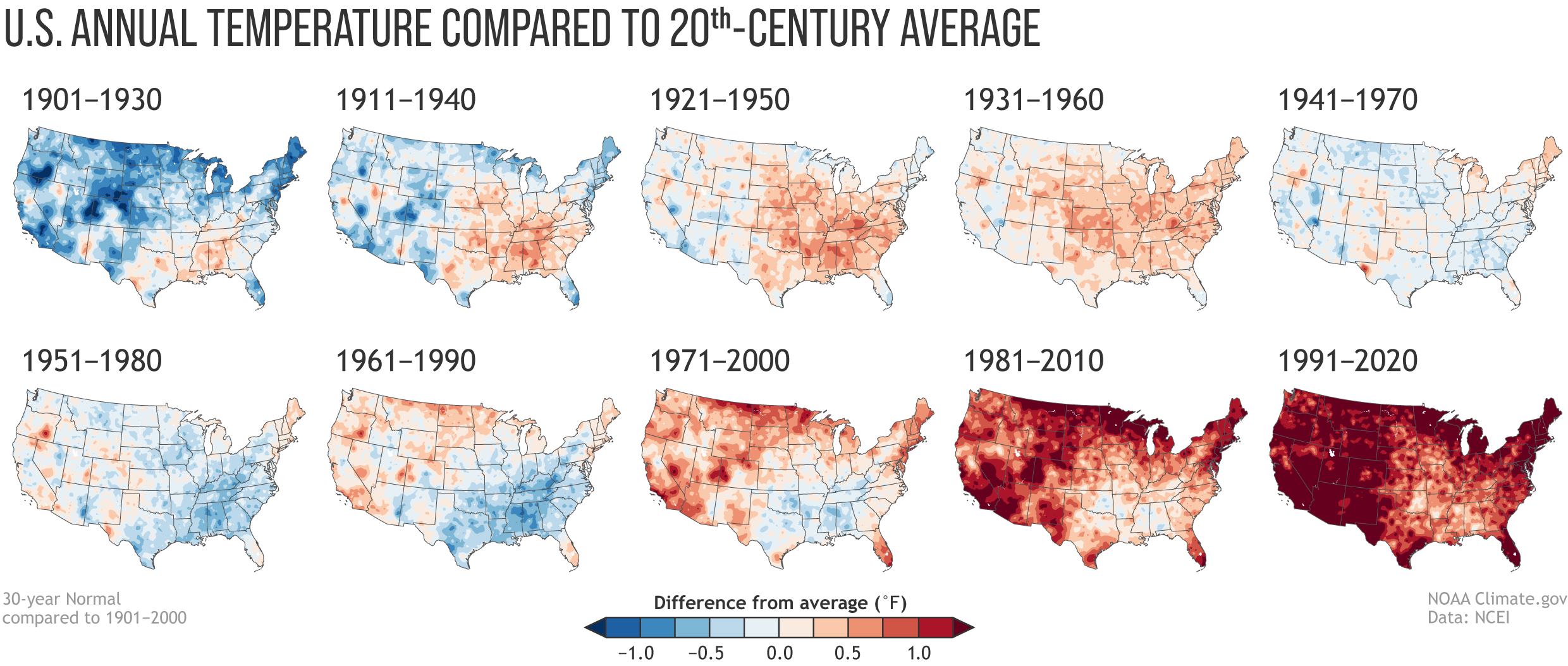
Image: NOAA
The models developed in the 1980s suggested the wet areas of the country will become wetter, and the dry areas will become drier… is this happening?
It appears so…
In the image below published by NOAA you see a series of national maps divided by 30-year periods. The colors indicate wet and dry periods as compared to 20th century averages for those areas. The reds and browns indicate below average rainfall, the greens and blue-greens above average rainfall. You can see at the beginning of the century most of the country was near the century mean. Over the first 50 years there was dry period, which included the famous “dust bowl”. The southwest United States experienced a very dry period in the middle of the century. Beginning in the 1970s it became wetter, with the midwest and northeast become very wet since that time, and the southwest is returning to the dry periods they saw earlier in the century.
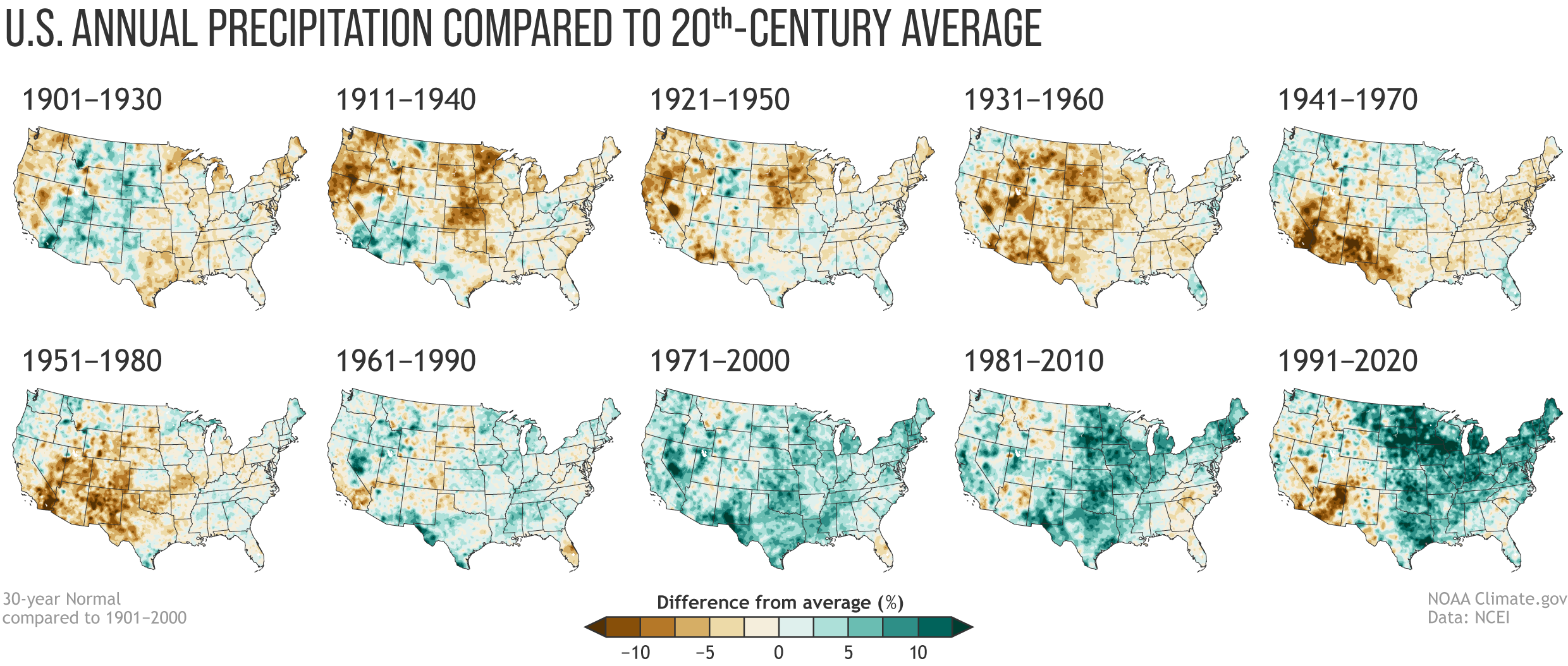
Image: NOAA
At least some of the wetness relative to the 20th century averages is linked to the warming of the atmosphere. Rising temperatures have enhanced evaporation since the 1970s and increased atmospheric moisture and humidity across the middle and eastern portion of the country8.
In a 2021 publication looking at changes in hurricanes and tropical storms, NOAA discusses what are termed “normals”. These are 30-year averages of key atmospheric and climate observations from weather stations across the country. They can be used by climatologists to assess how both the weather and climate compare to “normal” over time.
Tropicalization
This is an interesting phenomena that is occurring, and one we are watching along the northern Gulf of Mexico. The idea is basically tropical climate of the lower latitudes is moving northward across the northern hemisphere, and southward in the southern. It suggests that a warming plant is making temperate areas of the earth more tropical.

A young red mangrove growing near Pensacola FL.
Photo: Carrie Stevenson
Locally in the Pensacola area, there have been reports of mangroves growing in some estuaries. Mangroves are coastal salt tolerant trees that do not do well in colder temperatures. Historically, these plants dominated the estuarine coastlines of south Florida and Keys reaching as far north as Tampa Bay area along the Gulf coast, and Indian River area on the east. Over the last few decades there has been a migration of mangroves northward. They are now established in Cedar Key on the Gulf coast and reaching the Jacksonville area along the Atlantic. But even more interesting are the reports of small groups, or individuals of mangroves even further north into Georgia, and along the northern Gulf coast including Pensacola. Working with the Pensacola-Perdido Estuary Program, Sea Grant from Mississippi-Alabama and Florida, and NOAAs National Estuarine Research Reserves along the northern Gulf, we have been conducting annual surveys for these trees since 2019. Individual plants have been reported from the barrier islands of Mississippi, coastal inlets in Pensacola and Panama City, and numerous plants in the St. Joe Bay area. Black mangroves (Avicennia germinans) are more tolerant of cold than the other species of mangroves, and they have been found across the northern Gulf. What is interesting is that the red mangrove (Rhizophora mangle) has also been found. During the mangrove surveys we have conducted here in Pensacola Bay, the nine records we have were all red mangroves. These have not become established here, as a matter of fact all nine plants died during a hard freeze in 2018, but the fact that all reached a height of about 20 inches suggested that winter seasons are warm enough, for long enough, to allow them to grow for a period of time. One red mangrove growing within Big Sabine survived for almost 10 years, reaching a height of about a meter and developing prop roots, before the hard freeze of 2018 killed it. In addition to this survey project, others have reported the expansion of these plants into the northern Gulf2, 9.
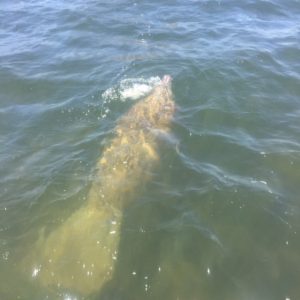
Manatee swimming in Big Lagoon near Pensacola.
Photo: Marsha Stanton
But mangroves are only one tropical species suggesting a climate shift. Manatees are animals that have historically migrated into the northern Gulf region over the years. Having lived in Pensacola all of my life, it was not unusual to hear about 1-2 sightings each year. Most were in the summer months but some were during the winter. They were often seen near the jetties at Ft. Pickens, near Palafox Pier downtown, and in Bayou Texar. However, in recent years the number of sightings seemed to be increasing. Some of citizen science volunteers were reporting them in Big Lagoon, and many times multiple individuals at one time, one report had nine individuals at the end of a private dock – which was unusual. In 2019 Sea Grant, working with Dauphin Island Sea Lab, decided to begin a tracking/reporting project to determine how frequent these encounters were. Dauphin Island Sea Lab had been conducting a “manatee watch” for almost 10 years at that time due to an increase in encounters in the Mobile Bay area. In 2019 we logged 66 records in the Pensacola Bay area. Based on time of day and location, we could determine that at least five of these were the same individuals reported by different people. Records came from the shoreline of the Gulf of Mexico, Santa Rosa Sound, Big Lagoon, NAS Pensacola, Tarkiln Bayou, Bayou Chico, Bayou Texar, and even up in Blackwater Bay near Bagdad. There were numerous manatees exploring all over the bay. This was different. The Manatee Watch program continues with a new reporting location on the Pensacola-Perdido Bay Estuary Program’s website – www.panhandlemanatee.org – and we continue to track this.
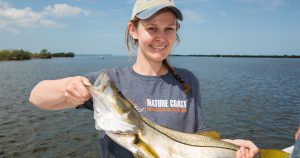
This snook was captured near Cedar Key. These tropical fish are becoming more common in the northern Gulf of Mexico.
Photo: UF IFAS
Now there are reports of snook (Centropomus undecimalis) and tarpon (Megalops atlanticus) roaming the northern Gulf. These are popular game fish found in south Florida associated with mangrove swamps and are a big draw for tourism in that part of the state. There have been reports of tarpon in the Pensacola Bay area for a number of years, but they seem to pass through seasonally and anglers reported that they would not strike any type of bait (live, dead, or artificial) thrown at them. However, in recent years there have been reports of anglers catching them.
Snook are more tropical and reports of them dispersing north are more recent. They are now reported in the Cedar Key area and enough to consider including them as a charter fishing target. Other reports from the Apalachicola area and even in Pensacola – Mobile Bay areas, suggest they are visiting us – albeit in small numbers.
But researchers have been following the “tropicalization” trend not only in the Gulf of Mexico but across the planet. Much of this is due to a reduction of the number of below freezing days during the winter period. One study showed that San Francisco CA has seen a reduction of sub-freezing days. Prior to 1980 most winters had sub-freezing days. In 1949 they had a total of 17 days below freezing. However, between 1981-2020 there were only 14 days below freezing, they have only had one since 1999, and have not had any since 20089. This same report looked at Tucson AZ, New Orleans LA, and Tampa FL. Tucson has experienced a slow warming over the century. New Orleans had relatively few sub-freezing days between 1940-1950, with an increase in freezing days between 1960-1980, and over the past 30 years a reduction in those freezing days. Between 1961-1990 there were 480 days below freezing. Since 1991 there have only been 165 days below freezing. The data from Tampa FL mimics what occurred in New Orleans9.
Along with the northern expansion of tropical species there has been a shift in the traditional “planting zones” used by agriculture and horticulturists. These are zones developed to let people know which plants will do best in your climate, and when to plant them. All of these zones are shifting north8.
And then there are coral reefs…
Long associated with the tropics, many species are now being found in the northern Gulf of Mexico and one scientific team predicts that as reefs continue to struggle with increasing water temperatures and ocean acidification, they will expand northward into the Big Bend region of Florida1.
Invasive Species
Everyone has heard of invasive species and are aware of the potential problems they can cause. With all of the media about Burmese Pythons, Brazilian Pepper, and Green Iguanas, it seems south Florida is under constant attack by these creatures. It’s understandable that Miami would be ground zero for such invasions. With the heavy international traffic and warm tropical climate creatures that are either intentionally, or accidentally, brought there and escape do well.

The Burmese python.
Photo: University of Florida
But most are not fond of the colder winters found in the northern Gulf of Mexico. Temperatures reaching, and sometimes exceeding, the freezing point are not unheard of. This has actually helped impede the dispersal of these tropical invasive species into the Florida panhandle.
That could be changing.
With over all milder winters we are seeing not only the tropicalization of the northern Gulf by native flora and fauna, but by non-native as well. Brazilian Pepper (Schinus terebinthifolius) has been reported on St. George Island near Apalachicola. The national database EDDMapS12 reports 18 records of the Cuban Treefrog (Osteopilus septentrionalis) in the Florida panhandle and there is reason to believe one population near Panama City may be breeding. There are 10 records of the Argentine Black and White Tegu (Salvator meriana) in the Florida panhandle and another 11 further north in the state of Georgia12.
A recent study looking at the cold tolerance of the Burmese Python (Python molurus) may be greater than we thought, that specific cold tolerant genes are becoming more common in the population, and the winters are getting milder9. All of this spells problems as these once south Florida issues begin to disperse northward.

The types of plants and planting zones are moving northward.
Photo: UF IFAS
Growth Zones
Also, along the lines of tropicalization, is the northward movement of growth zones. These zones are commonly used by horticulturalists when recommending plants for certain geographic areas. For example, much of our area of the northern Gulf is in zone 8. Zone 9 (warmer climate) can be found in other portions of the northern Gulf and in peninsula Florida. There is evidence to suggest that these growth zones are migrating northward with latitude and altitude with the changing climate8. This will be important for those in the nursery and gardening industry as they select species for markets in different parts of the country. These changes will also impact what time of year people choose to plant.
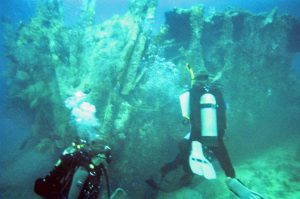
Coral reefs are struggling along the Florida Reef Track.
Photo: Indiana University
Corals, the Oceans, and Acidification – how have the oceans held up over the last decade?
For corals and ocean acidification, the answer is not so good.
NOAA reports that the oceans have absorbed enough CO2 to lower the pH by 0.1 – a 30% increase in acidity4. Mollusk shells, coral skeletons, etc. are made of calcium carbonate (CaCO3) which dissolves in acid. Obviously having a shell made of limestone (CaCO3) is not a good idea in an ocean that is becoming more acidic. The coral reef track has been dealing with life threatening diseases for many decades now. The increase ocean temperatures stress them, and the symbiotic microscopic plants known as zooxanthalle they rely on. This increase stress has made it easier for pathogens to attack them. There is currently a serious stony coral tissue disease spreading through the Florida reef tract that is also life threatening. The last decade has not been good for corals.
Sea Level Rise
Miami’s famous king tides…
Sea level is rising everywhere but some locations seem to be having larger issues than others. One such location is Miami FL. High tide occurs there twice a day. Twice each month, when the moon-earth-sun are all aligned during the full and new moons, the tides are larger than normal – spring tides. During certain times of the year these tides are stronger still – king tides. King tides are now covering portions of A1A in downtown Miami. These are not storm events causing flooding, they are natural high tides, just reaching higher levels because sea level is higher.
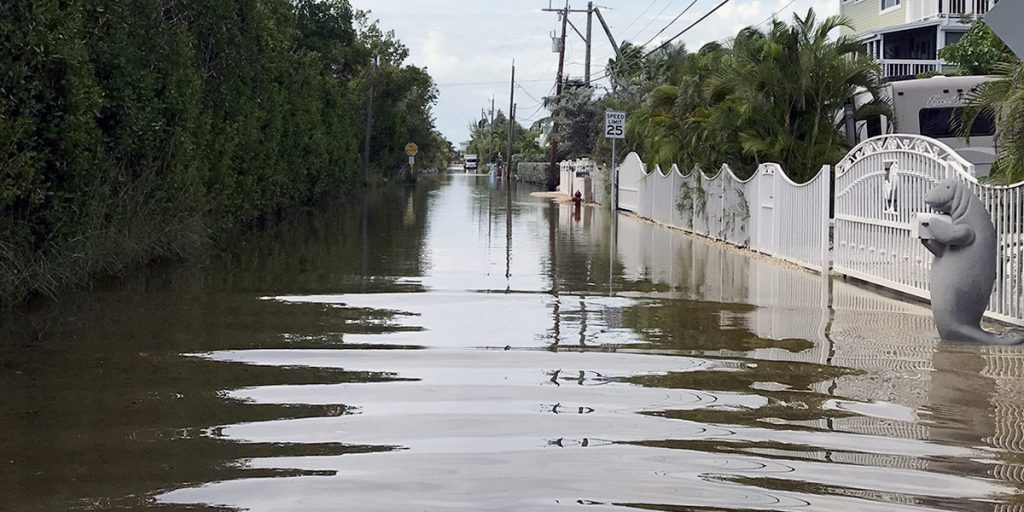
Flooding like you see along this street in Key Largo is becoming more frequent.
Photo: Florida Sea Grant
NASA reports that sea levels have risen eight inches over the past century and that the rate of that increase has doubled3. NOAA reports similar numbers and connects this rise to melting glaciers and expanding ocean volume due to warming. NOAA also connects the melting glaciers and expanding oceans to human activities since 19715, 7. In addition to Miami FL, there have been stories on impacts to London and Venice. Many coastal areas are beginning to see increased flooding due to both rising seas, sinking land, and increased rain events.
Data provided over the last decade do not suggest that the impacts of a changing climate have varied much from what the earlier climate models suggested. Some changes have occurred by impacts have not been noticed yet. More manatees and snook in the northern Gulf, growing/planting seasons shifting, mangroves moving north. Others have been impactful. Movement of invasive species, increased flooding, and the continued decline of our coral reefs. And we circle back to the original comment… “everyone is talking about the climate – but is anyone doing anything about it?”
In Part 3 we will review the recent report from the International Panel on Climate Change (IPCC) – Assessment Report #6 (AP6). What are the climate scientists saying about the current state of things and what are the models suggesting for the next decade.
References
1 Furman, B.T., B.J. Peterson, K.L. Heck Jr. 2020. Will the Florida Big Bend Area Become the Next Gulf of Mexico Reef Tract? Opinion Article. Frontiers in Marine Science. https://doi.org/10.3389/fmars.2020.00334.
2 Macy, A., S. Sharma, E. L. Sparks, J. Goff, K.L. Heck, M.W. Johnson, P. Harper, J. Cebrian. 2019. Tropicalization of the barrier islands of the northern Gulf of Mexico: A Comparison of herbivory and decomposition rates between smooth cordgrass (Spartina alternifloria) and black mangrove (Avicennia germinans). PLOS One. 14(1): e0210144. https://journals.plos.org/plosone/article?id=10.1371/journal.pone.0210144.
3 NASA. 2021. Global Climate Change: Vital Signs of the Planet. https://climate.nasa.gov/vital-signs/carbon-dioxide/.
4 NOAA. 2021. Climate.gov. Science and Information for a Climate Smart Nation. Climate Change and the 1991-2020 U.S. Climate Normals. https://www.climate.gov/news-features/understanding-climate/climate-change-and-1991-2020-us-climate-normals.
5 NOAA. 2021. Climate.gov. Science and Information for a Climate-Smart Nation. Carbon Emissions. https://www.climate.gov/news-features/understanding-climate/climate-change-atmospheric-carbon-dioxide.
6 NOAA. 2021. Climate.gov. Science and Information for a Climate Smart Nation. Sea Level Rise. https://www.climate.gov/news-features/understanding-climate/climate-change-global-sea-level.
7 NOAA. 2021. Geophysical Fluid Dynamics Laboratory. Global Warming and Hurricanes. https://www.gfdl.noaa.gov/global-warming-and-hurricanes/
8 NOAA. 2021. Geophysical Fluid Dynamics Laboratory. Historic Changes in Atlantic Hurricanes and Tropical Storms. https://www.gfdl.noaa.gov/historical-atlantic-hurricane-and-tropical-storm-records/
9 Osland, M.J., P.W. Stevens, M.M. Lamont, R.C. Brusca, K.M. Hart, J.H. Waddle, C.A. Langtimm, C.M. Williams, B.D. Keim, A.J. Terando, E. A. Reyier, K.E. Marshall, M.E. Loik, R.E. Boucek, A.B. Lewis, J.A. Seminoff. 2021. Tropicalization of Temperate Ecosystems in North America: The Northward Range Expansion of Tropical Organisms in Response to Warming Winter Temperatures. Global Change Biology. Wiley. DOI: 10.1111/gcb.1556.
10 Verges, A., C. Doropoulos, H.A. Malcom, M. Skye, M. Garcia-Piza. 2016. Long-Term Empirical Evidence of Ocean Warming Leading to Tropicalization of Fish Communities, Increased Herbivory, and Loss of Kelp. Proceedings of the National Academy of Sciences of the United States of Amercia. 113 (48) 13791-13796. https://doi.org/10.1073/pnas.1610725113.
11 Miller, G.T., S.E. Spoolman. 2011. Living in the Environment: Concepts, Connections, and Solutions. Brooks and Cole Publishing, Belmont CA. pp. 659.
12 Early Detection Distribution Mapping System (EDDMapS). 2021. https://www.eddmaps.org/.
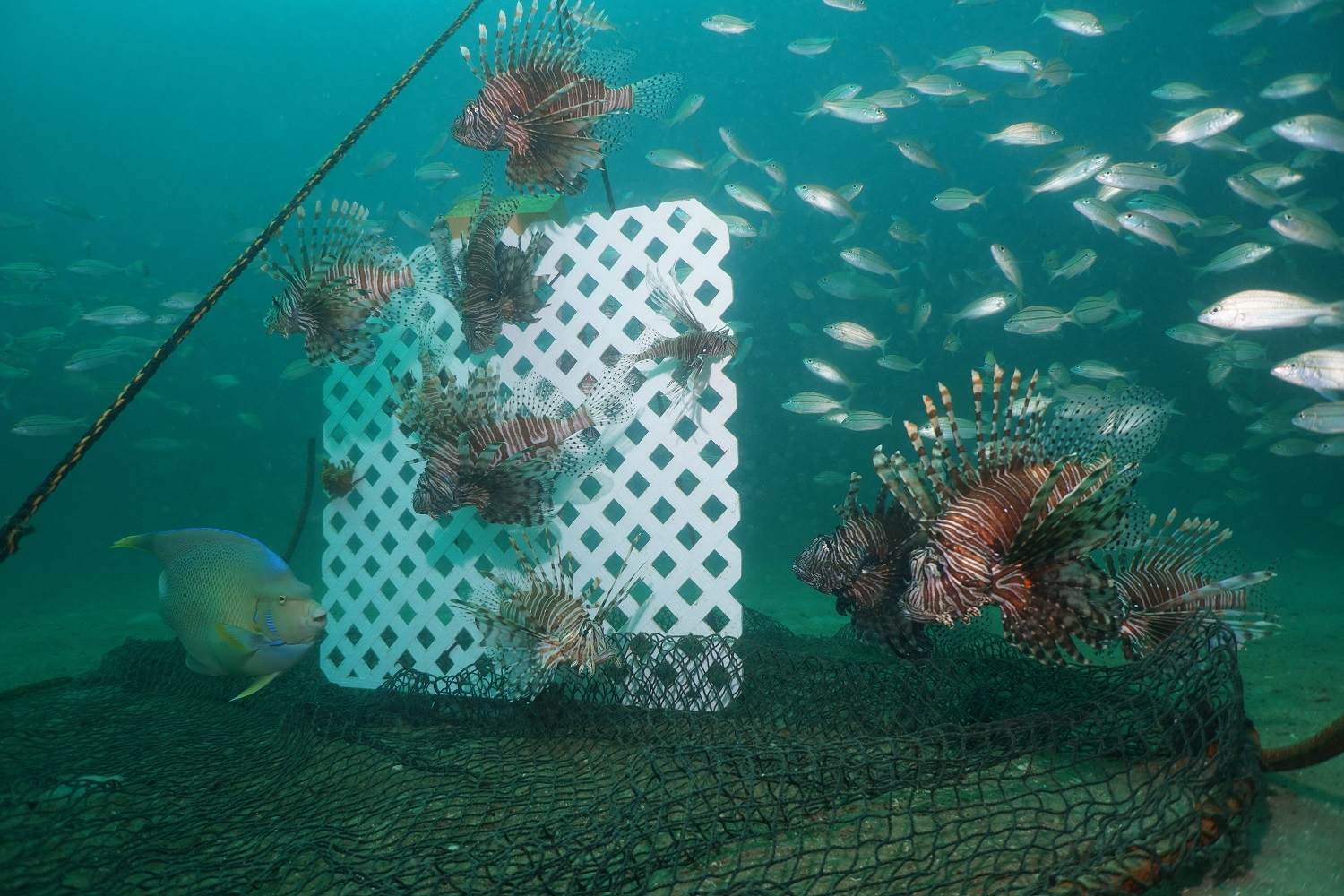
by Rick O'Connor | Sep 15, 2021
Six Rivers “Dirty Dozen” Invasive Species
Red Lionfish (Pterois volitans)
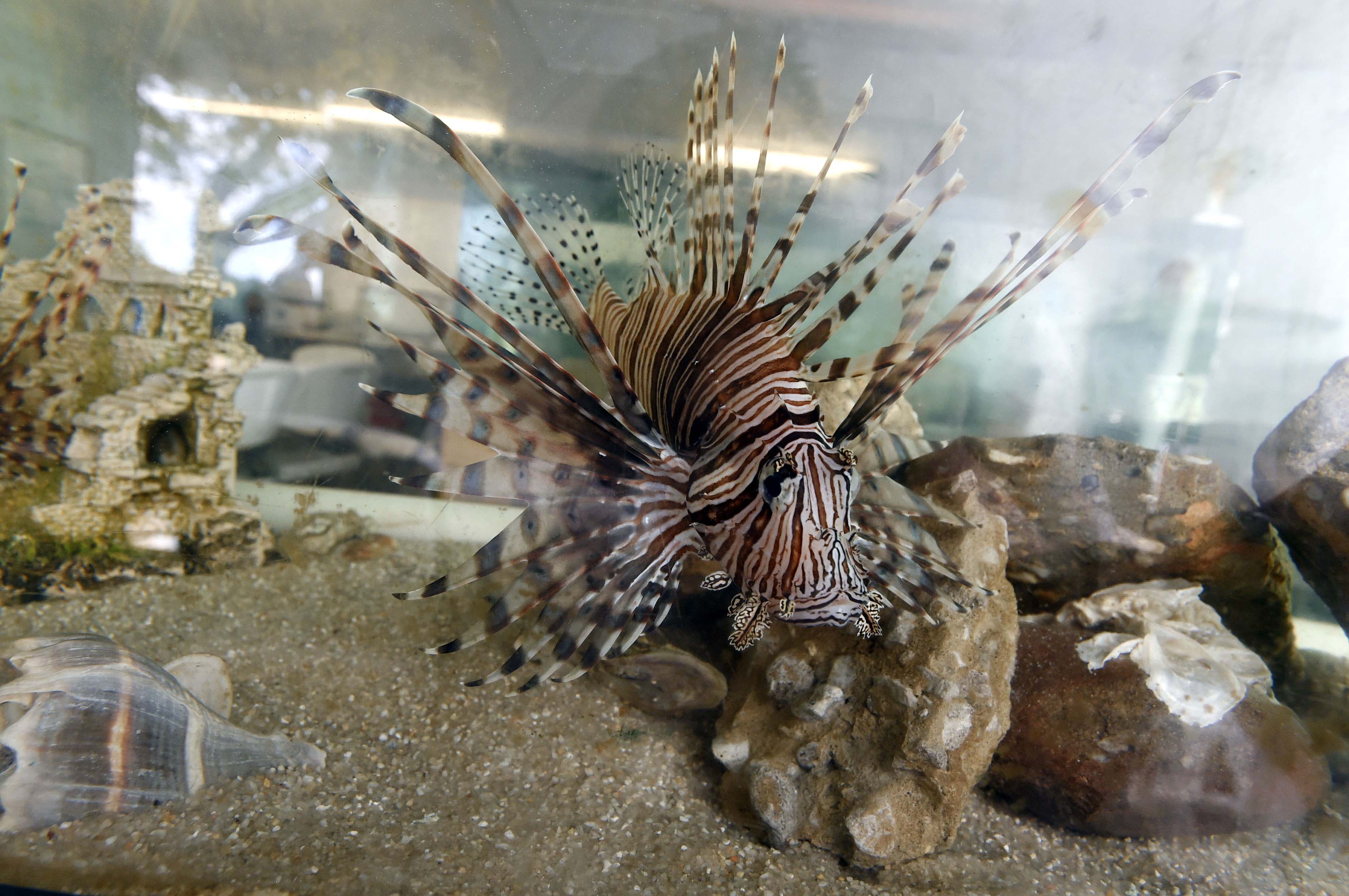
Lionfish in tank. Photo credit: Laura Tiu
Define Invasive Species: must have all of the following –
- Is non-native to the area, in our case northwest Florida
- Introduced by humans, whether intentional or accidental
- Causing either an environmental or economic problem, possibly both
Define “Dirty Dozen” Species:
These are species that are well established within the CISMA and are considered, by members of the CISMA, to be one of the top 12 worst problems in our area.
Native Range:
The Indo-Pacific and Red Sea.
Introduction:
The first record of lionfish in U.S. waters was in the late 1980s off the coast of Davie, Florida. It is believed the release was connected to the aquarium trade but whether it was accidental or intentional is unknown.
EDDMapS currently list 3,029 records of lionfish in the U.S. This is certainly under reported. Few invasive marine fish are reported to EDDMapS. Most are reported to a NOAA website which reports area of lionfish rather than individual records. It is known that the lionfish is well established all along the eastern seaboard of the United States, Bermuda, the Caribbean, and the entire Gulf of Mexico – including the coastal areas of Six Rivers CISMA. In 2014, it was reported that the densities of lionfish off the Six Rivers CISMA were some of the highest in the entire south Atlantic Region1. At a regional workshop in 2018, it was reported these densities had declined in waters less than 200 feet2.
Description:
Lionfish are deep bodied fish with large dorsal and pectoral fins and a truncate caudal fin. It is a slow swimmer. The body has a white/maroon vertically striped pattern that includes the head. The dorsal spines extend above tissue of the dorsal fin and possess a neurotoxin that is quite painful. The enlarged pectoral fins resemble wings and are used by the fish to corral prey into corners. There are no venomous spines on the pectoral fins but there are on the pelvic and anal ones. Lionfish have a large gaping mouth that can swallow a variety of prey using an engulfing/vacuum method.
Issues and Impacts:
These are voracious predators and have been known to consume over 70 different species of small demersal reef fishes. These small fish play an important ecological role on the reefs they inhabit, such as prey for larger commercially sought-after fish species as well as those that graze algae and keep the corals from being smothered by such. The decline of these populations can have both ecological and economic impacts. Studies have found that the popular red snapper will stay further away from reefs inhabited by lionfish, and they are also known to inhabit lobster traps in the Florida Keys, impeding the entry of the much sought-after spiny lobster.
Management:
The high reproductive rate has made lionfish management difficult. Adult females are known to produce an average of 30,000 fertilized every four days. The fertilized eggs are encased in a gelatinous sac that drifts with the currents and disperses the young to new territories. There are toxins associated with this sac and consumption of larvae is not currently known. In addition to high reproductive rates, the currents disperse the developing young great distances and lionfish are known to tolerate salinities found in estuaries.
They rarely bite hook and line making the most effective of removal being the diver with a pole spear. There are very good lionfish hunters, and prize-winning tournaments are well attended, but studies have shown that removals using spear must be repeated about once a month to be effective. Effective here meaning keeping the population stable, lionfish is a “Dirty Dozen” species, it will not be eradicated.
Test using traps are currently being conducted and these may prove to be more effective than removing by spear alone. There are a few native species that have been known to consume lionfish, but not at a rate to impact their invasion. Since 2018 lionfish in the south Atlantic region have been reported with skin lesions. It is not known at this time how this will impact their numbers, but early studies suggest it is.
For more information on this Dirty Dozen species, contact your local extension office.
References
Early Detection and Distribution Mapping System (EDDMapS)
https://www.eddmaps.org/
Six Rivers CISMA
https://www.floridainvasives.org/sixrivers/























